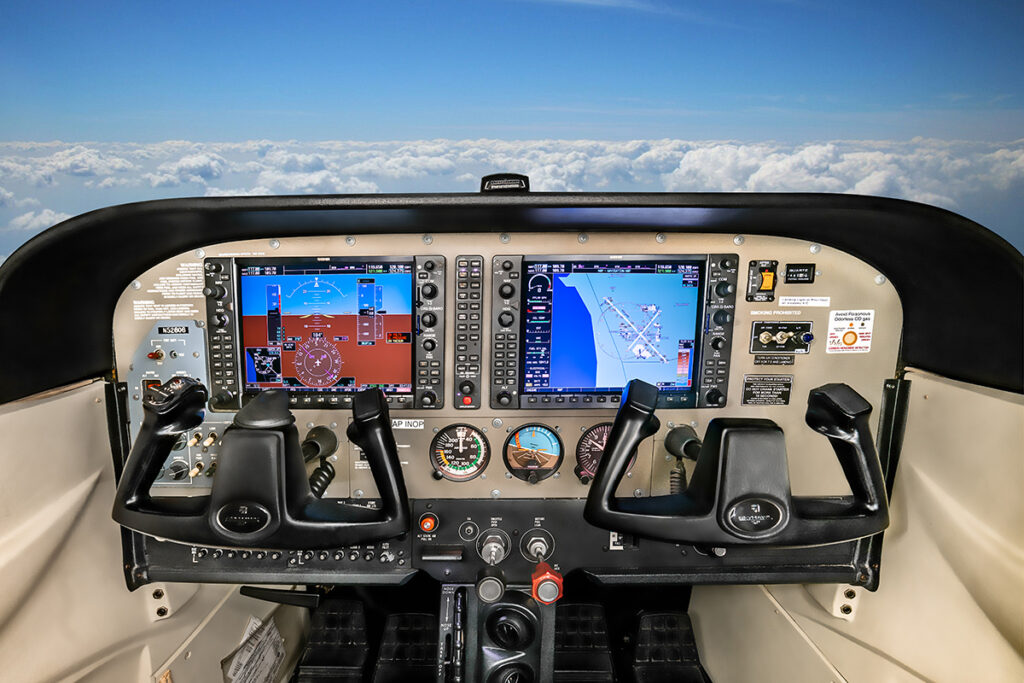
The Cessna 172 Skyhawk is one of the most iconic and beloved aircraft in general aviation. Since its first flight in 1955, it has been a favorite of flight schools, private owners, and commercial operators around the world. Known for its reliability, ease of use, and versatility, the 172 is an ideal aircraft for both training and recreational flying. But what makes the Cessna 172 Skyhawk so special, especially when it comes to its cockpit? Let’s take a closer look at what makes this aircraft’s cockpit a model of simplicity, functionality, and innovation.
The Layout: Intuitive and Pilot-Friendly
When stepping into the cockpit of a Cessna 172 Skyhawk, you’re greeted with a simple yet highly functional layout. Whether you’re a student pilot or a seasoned aviator, the cockpit is designed for ease of use and efficiency. The arrangement of the instruments and controls ensures that everything a pilot needs is within easy reach and easy to understand.
The cockpit features a high-wing design, offering excellent visibility for both pilots and passengers. This configuration also contributes to the 172’s stability, especially in turbulent conditions, making it a great aircraft for beginner pilots to develop their skills. The seat is adjustable, allowing pilots of various sizes to find a comfortable and optimal flying position.
Key Instruments: The Heart of the Cockpit
The instrument panel in the Cessna 172 Skyhawk is where the magic happens. It’s here that pilots monitor everything they need to control the aircraft, and the layout of the instruments is well-organized to keep all information visible at a glance.
- Primary Flight Instruments:
- Airspeed Indicator: The airspeed indicator is usually positioned prominently on the left side of the panel. It provides essential information about the aircraft’s speed relative to the air around it, which is crucial for various phases of flight, such as takeoff, climb, and landing.
- Attitude Indicator: Positioned just above the airspeed indicator, the attitude indicator shows the aircraft’s orientation in relation to the horizon. This is crucial for maintaining control, especially in poor visibility conditions, such as clouds or fog.
- Altimeter: The altimeter displays the aircraft’s altitude above sea level, which is essential for navigation and maintaining safe separation from other aircraft.
- Turn Coordinator: This instrument shows the rate of turn and helps ensure that the aircraft is turning at a safe, coordinated rate. This is important for preventing uncoordinated flight, especially during turns.
- Heading Indicator: The heading indicator is used to monitor the aircraft’s compass heading. Pilots use this to maintain a desired course while navigating.
- Engine Monitoring Instruments:
- Tachometer: This displays the engine’s RPM (revolutions per minute) and helps the pilot ensure that the engine is operating within safe limits.
- Oil Pressure and Temperature Gauges: These gauges monitor the engine’s lubrication system and temperature, ensuring that the engine is functioning properly and efficiently.
- Fuel Gauges: These indicate how much fuel is left in the aircraft’s tanks. They are crucial for ensuring that the pilot has enough fuel to reach the destination safely.
- Navigation Instruments:
- VOR Indicator: The VOR (Very High Frequency Omnidirectional Range) indicator is used for navigation. It helps pilots determine their position relative to a VOR station, allowing for precise navigation along established airways.
- GPS (for newer models): Many newer Cessna 172 models are equipped with modern avionics like the Garmin G1000. This system integrates GPS navigation, communication, and flight data into one advanced system, giving pilots more flexibility and control.
Flight Controls: Simple, Smooth, and Reliable
The Cessna 172 Skyhawk has a traditional yoke control system, which is what pilots use to control the ailerons and the elevator. This allows the pilot to adjust the aircraft’s roll and pitch, essential for maneuvering the aircraft.
- Ailerons (controlled by the yoke) help the aircraft roll around its longitudinal axis, aiding in turns.
- Elevators (also controlled by the yoke) control the pitch of the aircraft, helping the pilot climb, descend, or level out.
The pedals at the feet of the pilot control the rudder, which manages the aircraft’s yaw. The rudder is used in coordination with the ailerons to ensure smooth and coordinated turns.
The control feel in the Cessna 172 Skyhawk is known for being forgiving and light. This makes the aircraft a joy to fly, whether you’re executing your first flight lesson or performing more advanced maneuvers.
Avionics and Modern Updates
As time has gone on, the Cessna 172 has undergone numerous updates to its avionics. While older models often featured traditional analog instruments, newer versions are equipped with advanced glass cockpits like the Garmin G1000.
The Garmin G1000 integrates a range of avionics functions into a single, digital screen. This includes:
- Primary flight display (PFD): This provides essential flight data like airspeed, altitude, attitude, and heading.
- Multi-function display (MFD): This display offers detailed maps, engine data, and navigation information, providing a high level of situational awareness during flight.
- GPS Navigation: The G1000 makes navigation more precise with the ability to display routes, flight plans, and real-time GPS location.
These modern avionics systems make the Cessna 172 not only easier to fly but safer as well, providing advanced features like terrain awareness, traffic alerts, and weather information, all of which help pilots make informed decisions during flight.
Pilot Comfort and Ergonomics
One of the standout features of the Cessna 172 cockpit is its comfort. The cockpit is spacious for a light aircraft, offering adequate legroom for most pilots. The seats are adjustable, so pilots can find the most comfortable position for long flights. Visibility is also excellent, thanks to the large windows and the high-wing design, which allows the pilot to have a clear view of the surroundings.
The layout of the cockpit is designed with ergonomics in mind. The controls and instruments are positioned so that they are easy to access and operate. Everything is logically placed, reducing the pilot’s workload and increasing the efficiency of operations.
Conclusion
The Cessna 172 Skyhawk cockpit is a perfect blend of simplicity, functionality, and innovation. Whether you’re flying an older model with analog instruments or a newer version with a modern glass cockpit, the 172’s cockpit provides everything a pilot needs to fly safely and comfortably. It’s this combination of ease of use and reliability that has helped make the Cessna 172 Skyhawk the best-selling aircraft of all time and a favorite among pilots of all experience levels.
Whether you’re a student pilot taking your first lesson or an experienced aviator cruising through the skies, the Cessna 172 Skyhawk cockpit offers a dependable and intuitive flying experience. And that’s what continues to make the 172 such a beloved aircraft in general aviation.
Safe travels and happy flying! ✈️

Leave a Reply